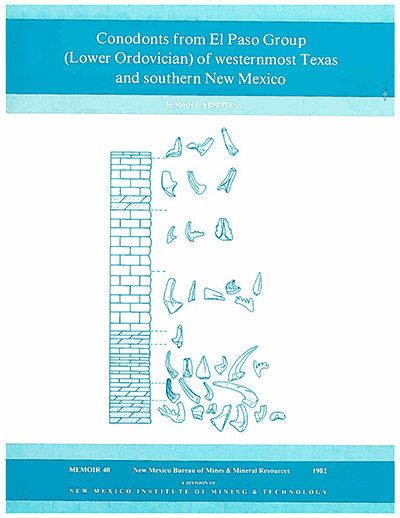
Memoir 40—Conodonts from El Paso Group (Lower Ordovician) of westernmost Texas and southern New Mexico
By J. E. Repetski, 1982, 121 pp., 1 table, 8 figs., 28 plates, 1 index.

Samples were taken at 20-ft intervals through a 410 m (1,345-ft) section of the El Paso Group in the southern Franklin Mountains of westernmost Texas and southern New Mexico as part of a detailed study of the conodonts of that unit. The succession is predominantly dolostone in the lower part and limestone in the upper part of the section. All of the 1-kg samples processed yielded conodonts. More than 16,500 conodont elements were recovered, and preservation of the conodonts ranges from poor to good. Altogether, 145 species are described and/or discussed taxonomically. The conodonts are distributed among 30 genera, of which Cristodus is new. Of the 145 species, 41 are discussed in terms of multielement taxonomy, and 104 are discussed in form taxonomy. New species named herein include: Clavohamulus lemonei, Cristodus loxoides, Drepanodus pseudoconcavus s. f., Histiodella donnae, Juanognathus hayesi, Oistodu? lecheguillensis, Protopanderodus leei, Reutterodus borealis, Scolopodus abruptus s. f., Scolopodus acontiodiformis, S. acontiodiformis angularis, S. bolites, S. filosus xyron, S. kelpi, S. parabruptus, S. carlae, and S. floweri. The conodonts range in age from early (but not the earliest) to late Canadian. North American conodont Fauna C is represented in the lowermost beds of the El Paso Group in west Texas. Diagnostic conodonts of Fauna D appear between 56-91m (180-300 ft) above the base of the section. Elements of Fauna E appear abruptly at 256 m (839 ft). Fauna 1 is represented in the uppermost El Paso; diagnostic elements of this fauna appear between 347 m (1,140 ft) and 396 m (1,300 ft) above the section base. Correlation by means of conodonts is discussed, and the El Paso faunal sequence is compared with faunas from Lower Ordovician conodont-bearing successions in the United States and abroad.
Conodonts of Early Ordovician age are as yet quite poorly known, especially considering the relatively widespread occurrence of rocks of that age. Contributing to the paucity of definitive studies of Early Ordovician conodonts, at least in North America, is the widespread occurrence through this interval of dolostones that are difficult to disaggregate. Sections that yield to acidizing techniques and that are partly to nearly continuous through the Lower Ordovician do exist, and several of these sections are presently the objects of intense conodont study. In North America, important sequences of this age being studied are those of the Great Basin; the Arbuckle Group of southern Oklahoma; the Canadian Rocky Mountains; the northern and central Appalachians; the Canadian Arctic; and the El Paso Group of western Texas, New Mexico, and Arizona.
The primary purpose of this paper is to report, describe, and illustrate the conodont fauna recovered from the type section of the El Paso Group. Secondly, the conodonts of the El Paso Group are compared and correlated, where possible, with conodont faunas recovered from Lower Ordovician sequences elsewhere. Most of this comparison is done within taxonomies. Biostratigraphic and taxonomic work is continuing on the conodonts from the El Paso Group and related strata from sections in the Florida and Caballo Mountains, New Mexico, and from other sections in New Mexico and southeastern Arizona, as well as on the fauna recovered for this study.
$15.75
Buy
Now
Also available as a free download.
Download
| File Name | Size | Last Modified |
|---|---|---|
| Memior_40.pdf | 6.60 MB | 01/19/2021 10:02:20 AM |
| Memior_40.zip | 6.93 MB | 01/19/2021 10:02:43 AM |
| Appendices: | ||
| Memoir_40_Appendices.pdf | 365 KB | 01/19/2021 10:02:29 AM |



